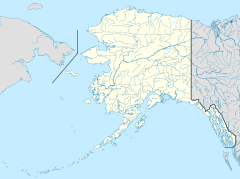Nome mining district facts for kids
Quick facts for kids
Cape Nome mining district
|
|
|---|---|
|
unincorporated mining district
|
|
The Nome mining district, also known as the Cape Nome mining district, is a special area in Alaska where people have found a lot of gold. It's famous for one of the biggest gold rushes in North American history!
The story began in 1898 when three friends, Erik Lindblom, Jafet Lindeberg, and John Brynteson, found gold. They were nicknamed the "Three Lucky Swedes." They discovered shiny gold pieces in the dirt and gravel near Anvil Creek and the Snake River, not far from where the city of Nome would later be built.
News of their discovery spread quickly, causing a huge rush of people to Nome in the spring of 1899. This was one of the first and the largest gold rushes in Alaska. Only the famous California and Klondike gold rushes were bigger.
At first, things were a bit wild and messy. About 20,000 people, including gold seekers, gamblers, and shop owners, arrived. There wasn't enough gold for everyone right away, and some people even tried to steal others' claims.
Then, someone had a clever idea: what if they looked for gold in the red and black sands right on the beach? Within days, gold was found for many miles up and down the beach from Nome! In 1899 alone, people collected over a million dollars' worth of gold from the beach. Later, even more gold was found in older beach lines further inland.
The creeks in the Nome District have produced a huge amount of gold over time. More than 3.6 million troy ounces (a way to measure gold) have been found! Anvil Creek, where it all started, even produced some of the largest gold nuggets ever found in Alaska.
Except for a short time during World War II, people have continued to mine for gold near Nome right up to today.
The Iditarod Trail's Connection
In 1908, a group called the Alaska Road Commission started building a long trail from Seward all the way to Nome. This trail was finished in 1911. After it was built, thousands of gold seekers used it to travel to other gold fields, like those in Iditarod. This big movement of people helped Alaska become an official territory of the United States.
Today, that same trail is famous as the Iditarod Trail, which is about 900 miles long. It's now used for the famous Iditarod sled dog race!
Rock Creek Mine: A Modern Gold Hunt
Even though most of the gold in Nome came from the surface (called "placer" gold), there are also gold deposits deep in the rocks. These are called "hard-rock" deposits.
A newer hard-rock gold mine, called Rock Creek, was built near Nome. It started operating in 2008. This project has two main parts: the Rock Creek mine and a processing plant (mill) about seven miles north of Nome, and another historic mine called Big Hurrah, about 42 miles east. Both are connected by roads.
The gold at Rock Creek is found in small veins of quartz rock within other types of rock. Long ago, miners tried to find these deep gold veins but couldn't find enough to make it worth their while. However, a smart geologist in 1908 realized that all these small veins together actually formed a "large low-grade gold deposit." This means there's a lot of gold, but it's spread out.
The Big Hurrah mine, which opened way back in 1908, was the biggest underground mine on the Seward Peninsula. It closed and reopened a few times over the years. Today, plans include bringing more gold-rich rock from Big Hurrah to the Rock Creek processing plant.
Both mines use a method called open pit mining, where they dig large holes in the ground to get the ore (rock with gold in it). They expect to find about 510,000 ounces of gold from these two sites combined!



